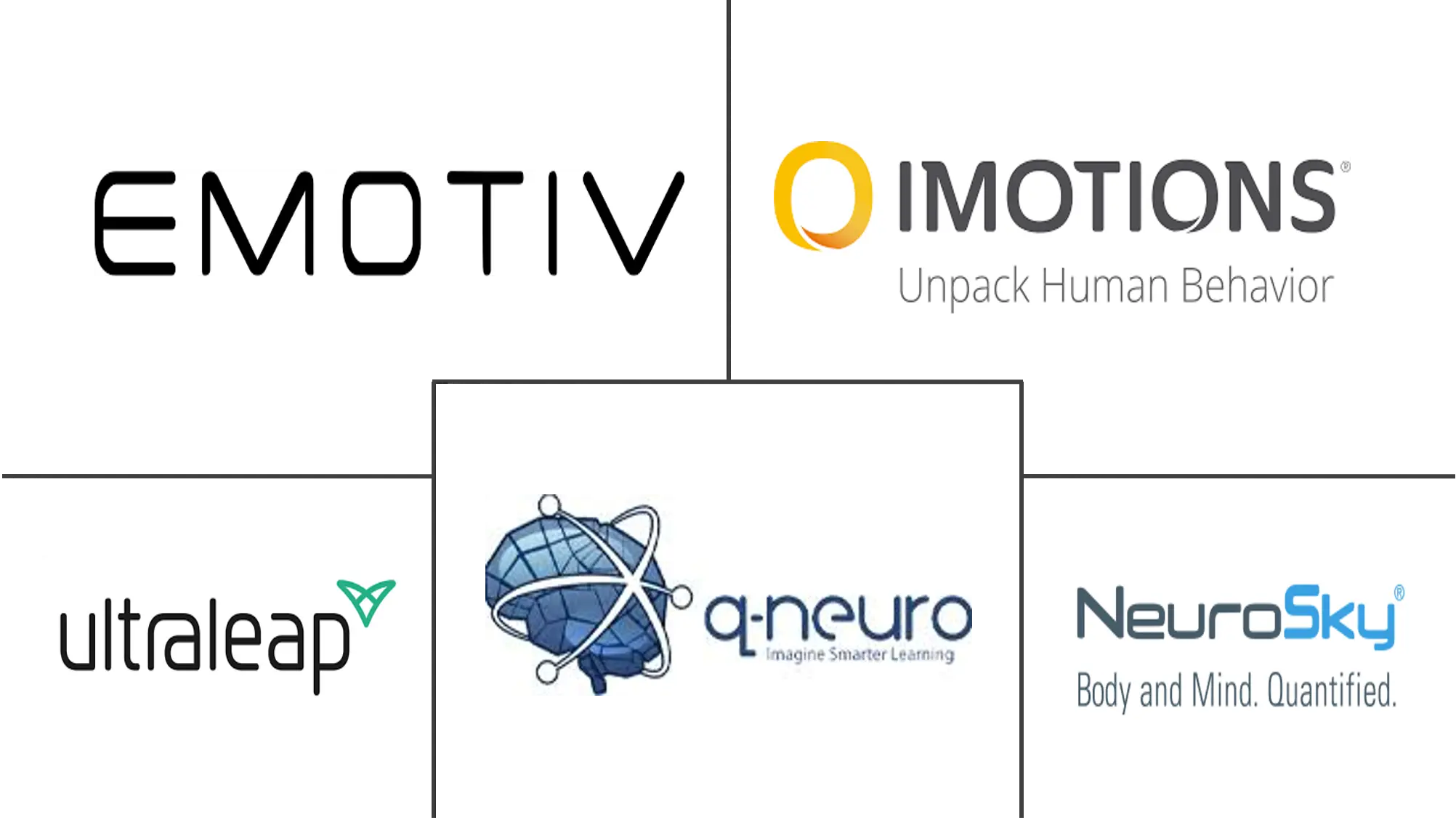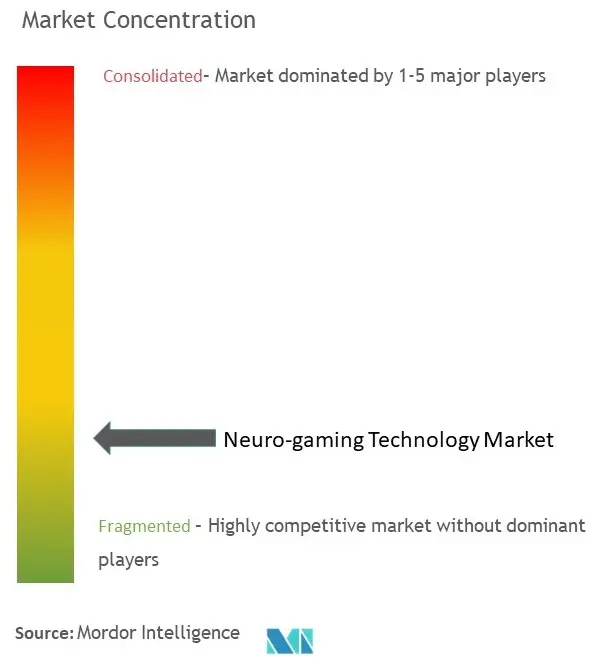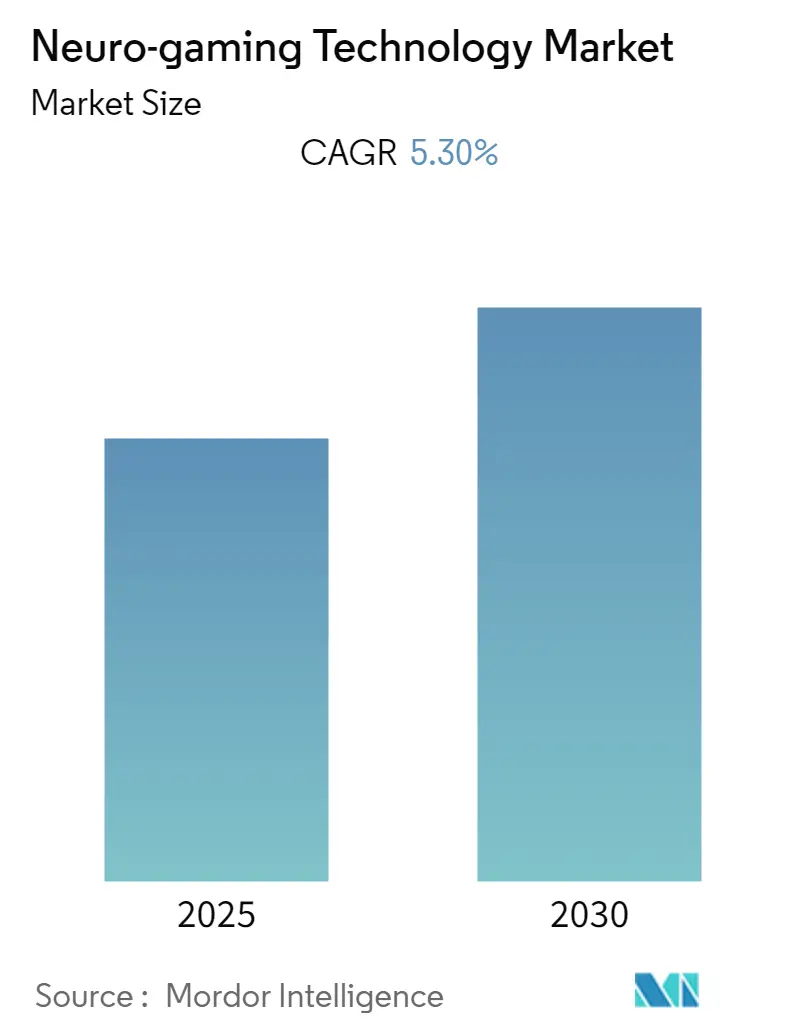
Neuro-gaming Technology Market Analysis
The Neuro-gaming Technology Market is expected to register a CAGR of 5.3% during the forecast period.
- Latest technologies, such as Neuro-gaming technology, are being used to create advanced gaming hardware and software. Assisting in the process, many developers have been designing advanced games to help people improve physiological factors such as brainpower, health, and skills. Neurogaming may tap into brain waves, heart rate, pupil dilation, expressions, and emotions and can help advance gaming by enabling users to interact with a console directly through the nervous system and related physiological manifestations that can be converted into gaming control signals.
- The neuro-gaming technology is leveraging major technologies such as VR, AR, and haptic sensation systems for making new games. The gaming industry is continuously evolving with the adoption of the latest technologies to capture the attention and imagination of gamers across the world. Further, technological advancements to address the disorders in Children could drive the demand for the technology.
- Factors such as the increasing development of Brain-Computer Interfaces (BCIs), increasing usage of computers, laptops, and smartphones, and the rise in the adoption of smart devices act as some of the major drivers of the market. Besides, the surge in demand for more advanced technologies capable of adding multiple functionalities and features to the games is expected to drive further the demand for neuro-gaming technology.
- The culture of Neuro-gaming technology is still at an evolutionary stage. Hence, only a limited number of neuro games and a limited number of actions included in the game are available in the market. However, the rapid developments in the software and technologies could ensure that the neuro-games become more challenging with multiple actions.
- With a significant number of enterprises operating in the end-user industries such as healthcare, education, and entertainment impacted due to the lockdown restrictions amidst COVID-19, the market growth is expected to be challenged owing to a significant reduction in capital expenditure over the short term.
- Moreover, UTSA researchers launched the first worldwide Accessibility VR Game Jam, accessible to gamers with disabilities. But due to COVID-19, they worked to migrate the game jam to an online-only environment quickly. Further, post-pandemic, according to a recent study conducted by Verizon, gaming usage increased by 115% in the United States compared to the pre-pandemic period. The online gaming platforms and live streaming services also witnessed a record number of users throughout March and April. An increase in gaming traffic was witnessed during peak hours by 75% over the post-pandemic period.
Neuro-gaming Technology Market Trends
Education Segment is Expected to Hold Significant Market Share
- Mind reading or brain-computer interface technologies help improve learning and concentration skills. Additionally, studies have shown how neurogaming technologies can help people with Alzheimer's, ADHD, and other related conditions. Companies such as Neuroelectrics have developed an EEG headset designed to stimulate the brain while playing games to treat problems such as chronic pain and depression. The company claims that its product can also be used for stroke rehabilitation.
- Further, In July 2022, Georgia State University researchers used functional magnetic resonance imaging (fMRI) to discover that gaming could be a useful tool for training in perceptual decision-making. Frequent players of video games showed superior sensorimotor decision-making skills and enhanced activity in key regions of the brain when compared to non-players. The research project involved 47 college-age participants, with 28 categorized as regular video game players and 19 as non-players.
- Similarly, researchers and scientists from Aalto University in Finland are developing a computer game to treat depression. The game requires players to solve challenges in a fantasy city designed to afford a therapeutic benefit, which eases symptoms of depression and improves cognitive performance. The game is currently unsuitable for the elderly, people with severe psychotic depression, or the only treatment form.
- Game-based learning (GBL) "fits" with the nervous system's sensing-thinking-doing functionality as long as it is incorporated into the flow of educational stimuli. Additionally, GBL satisfies the normal "needs" of the brain. The brain's primary need is to stay alive and maintain control. The brain's second requirement is to feel good, which includes having fun, playing, and receiving rewards. The brain's third need is to conserve energy by making things logical and consistent. Learning through games gives the brain a sense of control, delivers enjoyment, play, and rewards, and satisfies the desire to conserve energy by having a logical plot.
- With the increasing number of students and universities across the globe, the necessity of neuro-gaming technology is growing, according to the Times Higher Education, Tribhuvan University in Nepal has the maximum number of registered students in terms of full-time equivalents globally as of the academic year 2022/23, with 460,000 students. Payame Noor University in Iran and Al-Azhar University in Egypt, which came in second and third, had over 425,000 enrolled students. Egypt is home to many universities with the most students in the world.
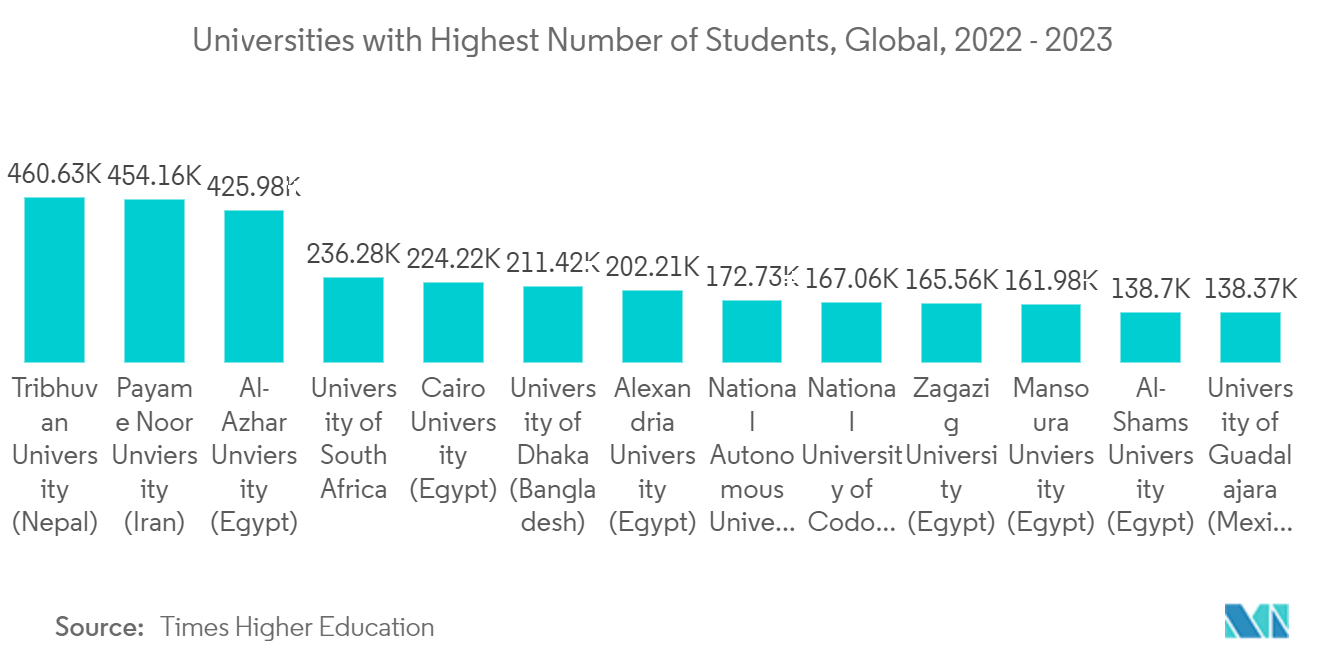
North America is Expected to Register the Largest Market
- Owing to the early adoption of technologies and the presence of many innovative developers operating in the market, Neuro-Gaming Technology has increased in the region. The increased adoption of video streaming apps on mobile devices and television to watch movies, TV shows, and live events on-demand has aided the Gaming industry in North America.
- Increasing awareness among users and the rise in the adoption of advanced gaming technologies are expected to create new growth opportunities for the players in the neuro-gaming technology market in the region during the forecast period. Psychologists and game developers have been working primarily to create games that can help boost the brain's function and provide therapeutic benefits to all those suffering from depression and other mental health disorders. For instance, Akili Interactive has built a standard iPad game that can measure the differences in brain activity between a normal child and one with ADHD or autism. The game measures 65 different pieces of data every second through the gameplay and collects clear signatures that come out of the game, which can tell exactly the cognitive deficits of the user.
- Further, the market is expected to be spurred by the ability of the technology to integrate real-time brain monitoring to engage and entertain users while maximizing learning efficiency, particularly in children with disorders. The number of children suffering from disorders in the U.S. is rising. Neuro-gaming technology can solve these issues and limit any further transition to more significant problems later in life. For instance, according to The U.S. Center for Disease Control and Prevention (CDC) estimates, one in every seven children (aged two to eight) suffers from a mental, behavioral, or developmental disorder. They also estimated that one in every five children (aged 13 to 18) could experience a severe mental disorder at some point in their lives.
- Canada's gaming enterprises, technologies, and products are witnessing an increasing demand. Multiple key factors, such as technological innovations, consumer preferences for new products, shifts in public perception, and innovations, have driven the expansion of the Canadian gaming industry. This has also attracted interest from international companies wanting to make a strong foothold in Canada. Further, the growth of virtual reality, augmented reality, and haptic sensation systems that aid neuro-gaming technology ensure the market's growth in the region. For instance, in recent years, Red Six Aerospace, Inc. developed an AR platform to train U.S. military aviators in air-to-air combat. Such developments are expected to aid the market's growth in the region.
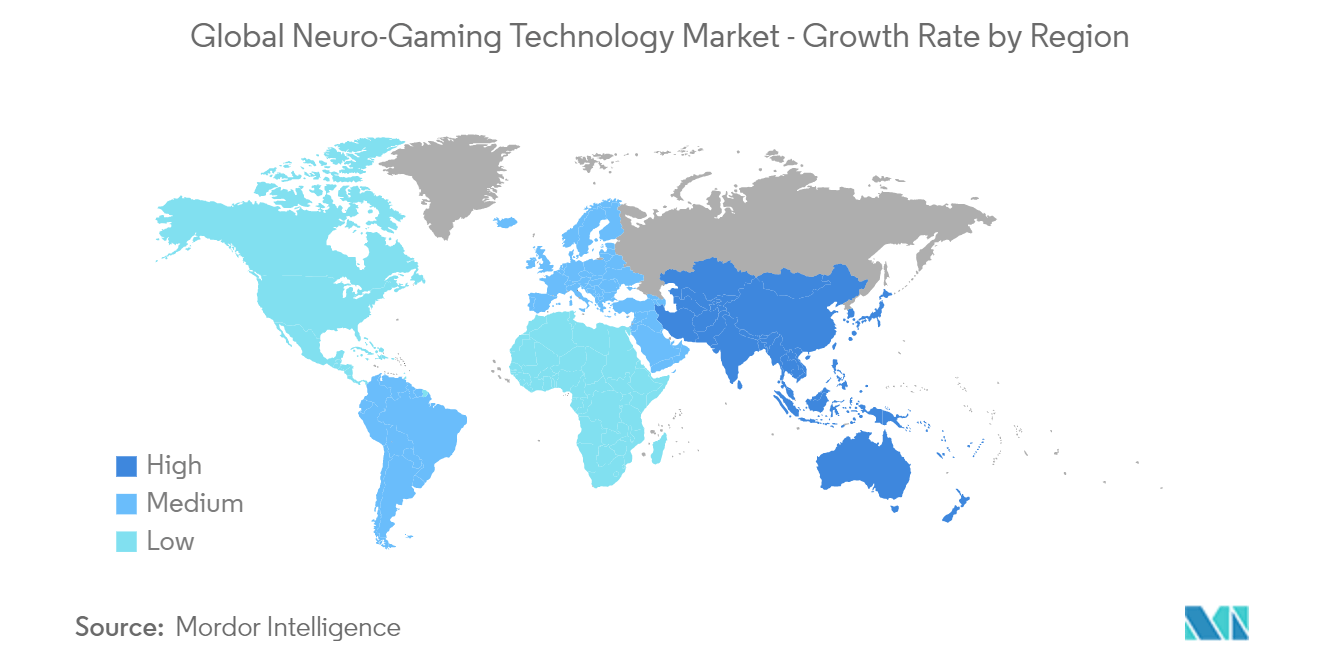
Neuro-gaming Technology Industry Overview
The global neuro-gaming technology market is moderately competitive due to the presence of multiple players. The players in the market are adopting strategies like product innovation, mergers, and acquisitions to expand their product portfolio, expand their geographic reach, and primarily stay competitive in the market. Some of the vendors in the market are Emotiv Inc., iMotions A/S, Qneuro Inc., and Ultraleap Ltd., NeuroSky Inc. among others.
- November 2022 - EMOTIV, a bioinformatics company that uses electroencephalography (EEG) to advance understanding of the human brain, and X-trodes, a company that brings wireless medical-grade monitoring solutions to the home environment, announced a collaboration on a new first-of-its-kind solution for simultaneous brain and physiological measurement that can be used outside of the lab setting.
Neuro-gaming Technology Market Leaders
-
Emotiv Inc.
-
iMotions A/S
-
Qneuro Inc.
-
Ultraleap Ltd.
-
NeuroSky Inc.
- *Disclaimer: Major Players sorted in no particular order
Neuro-gaming Technology Market News
- July 2022: The new game from Mindpeers is a ground-breaking development in health technology. It claims to give its users mental clarity, the ability to express their worries, and a sense of empowerment. As the name implies, the game's intriguing two-step journaling and self-exploration portion aid in clearing the skies or thoughts. According to research, when users express their feelings or thoughts, they can articulate, activating neocortical functioning.
- June 2022 - A professional-grade VR and XR headgear called the Varjo Aero claimed that it was the "first gadget in the world that concurrently measures the user's heart, skin, muscles, eyes, and brain." The headgear functions with the Galea platform, which combines hardware and software and utilizes brain-computer interfacing technology to operate on head-mounted displays. The Varjo Aero initially appears to be a standard wireless VR headset; however, the Galea version also includes a headband, face pad, and a set of dry, soft-polymer EEG electrodes.
- March 2022 - Snap Inc. acquired a Paris-based neurotech company to develop Snap's long-term AR research plans within Snap Lab. NextMind developed non-invasive brain-computer interface (BCI) technology, enabling hands-free interaction using electronic devices, including computers, AR/VR wearables, and headsets.
Neuro-gaming Technology Industry Segmentation
Neurogaming Technology is a kind of gaming technology that uses Brain-computer interfaces (BCIs) such as EEG so that users can communicate with the game without applying a traditional controller. When applying Multiplayer mode, members can view the brain activity of other users, such as the user's changes in emotional state, heart rate, pupil dilation, brain waves, and gestures, which are combined to enrich the game experience. The report highlights the demand and ongoing trends in different offerings in terms of components, catering to the needs of certain end-users globally. The estimates and trends help project the driving factors and estimations for the forecast period.
The scope of the study includes the solutions and hardware (XR headsets, etc.) geared to integrate aspects related to the brain functioning and overall nervous system into a gaming workflow, to improve/enhance the user's functioning. Based on the internal mapping undertaken for the study, these vendors cater to the healthcare and education sectors, with a wide range of conditions such as ADHD, Dyslexia, and others. Taking this into view, current addressable market measures at a consolidated level will be studied, segmenting the market by component (hardware and software), by end-user industry (healthcare, education, and entertainment), and by geography (North America, Europe, Asia Pacific, Rest of the World) in the final study.
The market sizes and forecasts are provided in terms of value in USD million for all the above segments.
| By Component | Hardware |
| Software | |
| By End User | Healthcare |
| Education | |
| Entertainment | |
| Other End Users | |
| By Geography | North America |
| Europe | |
| Asia Pacific | |
| Rest of the World |
Neuro-gaming Technology Market Research FAQs
What is the current Neuro-gaming Technology Market size?
The Neuro-gaming Technology Market is projected to register a CAGR of 5.3% during the forecast period (2025-2030)
Who are the key players in Neuro-gaming Technology Market?
Emotiv Inc., iMotions A/S, Qneuro Inc., Ultraleap Ltd. and NeuroSky Inc. are the major companies operating in the Neuro-gaming Technology Market.
Which is the fastest growing region in Neuro-gaming Technology Market?
Asia-Pacific is estimated to grow at the highest CAGR over the forecast period (2025-2030).
Which region has the biggest share in Neuro-gaming Technology Market?
In 2025, the North America accounts for the largest market share in Neuro-gaming Technology Market.
What years does this Neuro-gaming Technology Market cover?
The report covers the Neuro-gaming Technology Market historical market size for years: 2019, 2020, 2021, 2022, 2023 and 2024. The report also forecasts the Neuro-gaming Technology Market size for years: 2025, 2026, 2027, 2028, 2029 and 2030.
Our Best Selling Reports
Neuro-gaming Technologies Industry Report
Statistics for the 2025 Neuro-gaming Technology market share, size and revenue growth rate, created by Mordor Intelligence™ Industry Reports. Neuro-gaming Technology analysis includes a market forecast outlook for 2025 to 2030 and historical overview. Get a sample of this industry analysis as a free report PDF download.

